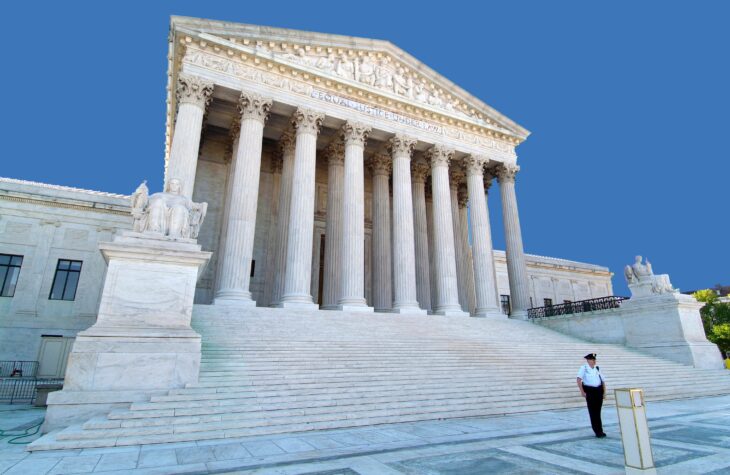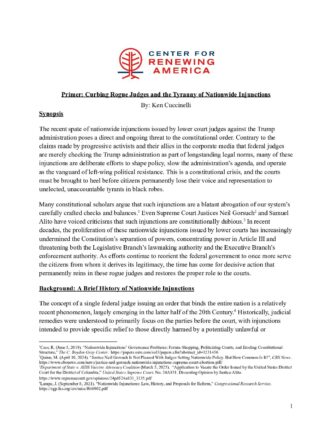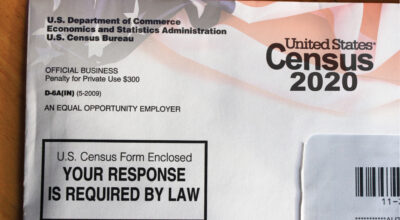
Primer: Curbing Rogue Judges and the Tyranny of Nationwide Injunctions

The unchecked proliferation of nationwide injunctions issued by rogue federal judges represents a dire threat to the American constitutional order. It undermines the separation of powers, empowers ideologues at the expense of citizens, and creates policy chaos through deliberate attempts to usurp the authority of both the Legislative and Executive branches.
Synopsis
The recent spate of nationwide injunctions issued by lower court judges against the Trump administration poses a direct and ongoing threat to the constitutional order. Contrary to the claims made by progressive activists and their allies in the corporate media that federal judges are merely checking the Trump administration as part of longstanding legal norms, many of these injunctions are deliberate efforts to shape policy, slow the administration’s agenda, and operate as the vanguard of left-wing political resistance. This is a constitutional crisis, and the courts must be brought to heel before citizens permanently lose their voice and representation to unelected, unaccountable tyrants in black robes.
Many constitutional scholars argue that such injunctions are a blatant abrogation of our system’s carefully crafted checks and balances.1 Even Supreme Court Justices Neil Gorsuch2 and Samuel Alito have voiced criticisms that such injunctions are constitutionally dubious.3 In recent decades, the proliferation of these nationwide injunctions issued by lower courts has increasingly undermined the Constitution’s separation of powers, concentrating power in Article III and threatening both the Legislative Branch’s lawmaking authority and the Executive Branch’s enforcement authority. As efforts continue to reorient the federal government to once more serve the citizens from whom it derives its legitimacy, the time has come for decisive action that permanently reins in these rogue judges and restores the proper role to the courts.
Background: A Brief History of Nationwide Injunctions
The concept of a single federal judge issuing an order that binds the entire nation is a relatively recent phenomenon, largely emerging in the latter half of the 20th Century.4 Historically, judicial remedies were understood to primarily focus on the parties before the court, with injunctions intended to provide specific relief to those directly harmed by a potentially unlawful or unconstitutional policy. The notion that a single district court judge could wield such sweeping power to halt the implementation of federal laws nationwide, outside the narrow scope of the parties present before the court, was largely absent from the early understanding of judicial authority and throughout much of our nation’s history.
Several factors have likely contributed to the rise of nationwide injunctions and Article III’s usurpation of power from both the Legislative and Executive branches. The unfettered expansion of the federal regulatory apparatus created more opportunities for legal challenges with broad implications. Indeed, the explosion in the administrative state largely stems from decades of Congress expanding the scope of government while also outsourcing its legislative responsibilities to federal agencies, who routinely add the proverbial “meat on the bones” of enacted statutes. Simultaneously, the political Left has increasingly used the courts to implement policies that either lack broad public support or would likely fail to make it through the legislative process.
Examples of such activist behavior are numerous and include the now-defunct Roe v. Wade, which invented a constitutional right to an abortion, Obergefell v. Hodges, which overruled state laws and mandated nationwide redefinitions of marriage, and Freedom from Religion Foundation, Inc. v. Chino Valley Unified School District, which saw the Ninth Circuit determine that prayer at the beginning of a school board meeting violated the Establishment Clause. As all layers of the federal judiciary have increasingly succumbed to practices that “legislate from the bench,” the judiciary has become infused with a mindset that seeks to unilaterally right political and policy “wrongs” as opposed to making neutral judgment calls grounded in the law and rooted in the Constitution.
Organizations like the American Civil Liberties Union (ACLU) are one of many progressive entities that exist to bring activist-minded cases before leftist judges in friendly jurisdictions to achieve the ruling that both parties (the organization and the judge) desire.
Following the Supreme Court’s reversal of District Judge James Boasberg’s recent nationwide injunction, which unconstitutionally halted the Trump administration’s removal of illegal immigrant Venezuelans belonging to Tren de Aragua under the Alien Enemies Act, the ACLU said the quiet part out loud and admitted to the game that they are playing. “We are disappointed that we will need to start the court process over again in a different venue…”5
Yet the recent Boasberg injunction, though reversed by the Supreme Court, indicates a much larger pattern of aggressive judicial political activism in the lower courts. Data on nationwide injunctions since the 2000 presidential election reveals an unmistakable upward trend that denotes a significant spike during both Trump administrations.
- George W. Bush Administration (January 2001- January 2009): According to the Harvard Law Review, a total of six nationwide injunctions occurred in eight years during the Bush administration.6
- Obama Administration (January 2009- January 2017): According to the Harvard Law Review, a total of 12 nationwide injunctions occurred in eight years during the Obama administration.7
- First Trump Administration (January 2017 – January 2021): According to the Harvard Law Review, 64 nationwide injunctions occurred in four years during the first Trump administration,8 an increase of 433 percent from the previous administration in just half the time.
- Biden Administration (January 2021 – January 2025): According to the Harvard Law Review, 14 nationwide injunctions occurred in the first three years of the Biden administration,9 a 78 percent decrease from the first Trump term.
- Second Trump Administration (January 2025 – March 27, 2025): At least 17 nationwide injunctions have already been identified,10 on pace for 102 injunctions over the next year and more than 400 for the entirety of the second Trump term, which would equate to a staggering 2,814 percent increase from the Biden years.
In a 2019 speech, former Attorney General William Barr noted that federal courts issued only 27 nationwide injunctions in the entire 20th Century.11 Some examples of nationwide injunctions issued against the Trump administration since January 20, 2025, include: preliminary injunctions against Executive Order 14160 that ends birthright citizenship,12 injunctions reversing the administration’s firing of federal employees,13 injunctions that force the administration to unpause funding freezes,14 temporary restraining orders (TROs) blocking the implementation of policies that define sex based on biological reality and protect children from genital mutilation procedures,15 and TROs prohibiting the Department of Government Efficiency from accessing specific programs as part of that entity’s government-wide audit authority.16
It is no coincidence that each of these examples aligns with President Trump’s core political priorities and is central to the policy mandate given to him by voters in November 2024. Since the turn of the century, there has been a clear, disproportionate use of nationwide injunctions against the Trump administration compared to progressive or more moderate presidential administrations. While the reasons for this increase may be subject to some debate, the harmful impact on the ability of a duly elected President to govern is undeniable. Further, the consequences such judicial freneticism poses to the constitutional order and the rule of law are significant.
Analysis: The Perils of Judicial Overreach
The unchecked use of nationwide injunctions poses a significant threat to our constitutional republic. This bastardization of the courts has created an ecosystem where appointed judges are increasingly willing to engage in policymaking from the bench, leading to an inevitable post-constitutional political dynamic.
The recent Boasberg injunction is a perfect example of how such rulings encroach on the federal government’s legislative and executive functions. Congress passes laws, and the President executes them. However, when a single district judge in a jurisdiction shopped out by ideologically-aligned activists has the power to unilaterally halt the implementation of policies nationwide, it effectively grants any single federal judge veto power not envisioned or supported by the Constitution.
This deliberate erosion in the separation of powers undermines the will of the people, expressed through their elected representatives. It transforms the judiciary away from an arbiter of prospective disputes into a backstop to fulfill specific political objectives. And frequently, those objectives are oriented to sway public opinion or throw proverbial “sand in the gears” to slow down the political opposition by empowering unelected judges to substitute their policy preferences for those of the electorate. The practical impact is that such injunctions undermine the very democratic process that progressives often tout as their north star.
Perhaps most alarming is that the threat of nationwide injunctions operates as a “Sword of Damocles” that creates instability and uncertainty for policymakers in the government and those potentially impacted in the private sector and beyond. If policies can be halted at any moment by any singular judge for any particular reason at the request of any astroturfed cause, then the system is no longer attempting to provide a legal remedy for a prospective dispute but is instead actively facilitating chaos to achieve a desired political outcome.
The strategic use of forum shopping proves this true. Litigants aligned with activist organizations know that a friendly judge can slow down their duly elected political opponents through an expectation of nationwide freezes. This means that even if injunctions are ultimately overturned on appeal, such rulings often delay the implementation of critical policies for months or even years, hindering the ability of elected officials to address pressing issues affecting American citizens.
This dynamic fuels the proverbial arms race between conservatives and progressives to stack the court with ideologically aligned judges. For the political Right, that mostly means supporting originalists who adhere to the Constitution and refrain from “legislating from the bench.” For the political Left, that mostly means supporting progressive jurists who see the Constitution as an ever-changing document that, in its original form, mostly hinders the “march toward progress.”
Thus, the current dynamic provides for a single district court judge to effectively dictate policy for more than 330 million American citizens. This is the textbook definition of a constitutional crisis, which is unsustainable. Further, it is a crisis that should have been rectified long ago.
Despite concerns raised by some justices regarding the legality and propriety of nationwide injunctions, Chief Justice John Roberts has failed to take decisive action to curb this practice. While he has occasionally joined dissenting opinions that criticize the scope of lower court orders, he has not spearheaded an effort to establish clear limitations on the power of district judges to issue nationwide injunctions.
Chief Justice Roberts has an established preference for issuing narrow rulings out of a misplaced belief that such approaches prevent the politicization of the Court. His failure to forcefully address this issue of lower court injunctions, however, has only allowed the problem to fester and worsen, undermining the legitimacy of the judiciary. It is the Supreme Court’s job to bring its lower courts to heel if they are routinely abrogating their Article III parameters. Specifically, the Court must ensure the proper functioning of the Judicial Branch and uphold the separation of powers. The proliferation of nationwide injunctions directly undermines these principles. It is well within the high court’s capacity to issue rulings that establish clear standards for injunctive relief and limit the scope of Article III’s ability to bring the Executive Branch to a screeching halt on the whims of a single judge.
There is simply no excuse for these practices to continue.
Policy Approach: Permanently Ending Activist Judges
While the Supreme Court has mostly failed to rein in the activists that proliferate in the lower courts, both Article I and Article II have tools at their disposal that can permanently resolve this escalating constitutional crisis. Indeed, restoring the proper balance of power requires a multi-pronged approach, targeting both the incentives and the mechanisms that enable judicial overreach. Reining in rogue judges will require both Congress and the Executive Branch to unflinchingly assert their constitutionally prescribed authority to check a Judicial branch that remains out of control.
In recent months, significant attention has been paid to prospective impeachment proceedings against rogue judges who abdicate their constitutional parameters.17 In many cases, impeachment is indeed warranted. However, the ability to successfully impeach and remove a sitting federal judge within the current congressional paradigm is limited at best. As such, this is mostly a distraction from more promising and general approaches.
On April 9, 2025, the House of Representatives passed the No Rogue Rulings Act (NORRA) spearheaded by Rep. Darrell Issa (R-CA), which limits injunctive relief to only the parties before the court and provides for a random three-judge panel to determine if an injunction should be issued if multiple states bring a case in different districts. This is a positive development that, should the Senate pass it, would help mitigate some of the chaos in the lower courts. It also sets a strong precedent: it begins the much-needed process of Congress asserting itself amid a broken judiciary. However, there is much more that Congress should do to restore the proper constitutional balance and deprive Article III of its blatant power grab.
Potential Legislative Remedies
1. Limit Injunctive Scope: Congress possesses the inherent authority to define the jurisdiction and remedies available in federal courts. Legislation like NORRA should be enacted to clarify the permissible scope of injunctive relief, explicitly limiting it to the parties directly before the court. This would prevent single judges from imposing their policy preferences on the entire nation and relegate such relief only to the litigants represented in that particular case.
2. Strip Jurisdiction: Congress has the authority to strip courts of their jurisdiction on certain issues. A good start is to pass legislation that prohibits the courts from having jurisdiction on border security issues, deportations, or any other immigration-related national security issue that squarely falls within the sole purview of the Commander-in-Chief. Former Rep. Louie Gohmert (R-TX), who was also a judge, offered multiple bills during his tenure in Congress aimed at setting new issue parameters to prevent courts from issuing nationwide injunctions by removing their jurisdiction over certain policies.
3. Tighten Standing Requirements: The doctrine of standing ensures that federal courts only hear cases where the plaintiff has suffered a concrete and particularized injury. Congress should tighten these requirements to prevent activist groups like the ACLU from bringing broad challenges to federal laws based on generalized grievances.
4. Amend Judicial Review: The Administrative Procedures Act (APA) governs the judicial review of agency actions. Congress should amend the APA to clarify that courts can only grant relief to the specific parties before the court, preventing the use of the APA as a basis for nationwide injunctions against agency rules or policies that come out of the Executive Branch.
5. End Forum Shopping: Congress should pass legislation restricting plaintiffs’ ability to file suit challenging federal policies in any district court nationwide, addressing the problem of forum shopping. One solution here is that cases should be required to be filed in districts where the plaintiffs reside and are directly affected by the policy.
6. Require Unanimity on Appellate Panels: Congress should consider legislation that requires a unanimous decision by an Appellate Court panel to implement a nationwide injunction. Further, the legislation should statutorily prohibit a single district court judge from enacting a nationwide injunction under any circumstances until review by an Appellate Court.
7. Reform Temporary Restraining Orders: Currently, temporary restraining orders (TROs) are often not immediately appealable, allowing them to remain in effect for extended periods and cause significant disruption. Legislation making TROs immediately appealable would provide a crucial check on their potential for abuse. In the case of an Appellate Court panel decision that could result in a nationwide injunction, such a mechanism should be proscribed that results in expedited review to the Supreme Court.
8. Abolish and Reconstitute: The ultimate congressional remedy is to defund the courts in question through the appropriations process and then reconstitute them with a new authorization bill after such rogue courts have been summarily purged of post-constitutional activists posing as judges. This would allow Congress to reforge the new district or appellate courts, even changing the physical boundaries of the related jurisdictions if necessary, and provide the Executive Branch with an opportunity to nominate new judges who hold actual fidelity to the Constitution.
Simultaneously, the Executive Branch must also reassert its constitutional prerogatives over these activist courts. Some of these approaches require innovative solutions that dial up the pressure, while others are simply a matter of willpower.
Potential Executive Remedies
1. Enforce Civil Procedure: Under Rule 65(c) within the Federal Rules of Civil Procedure, plaintiffs seeking preliminary injunctions or TROs are required to post security to cover the government’s potential costs and damages if the injunction is later found to be wrongly issued. The Executive Branch should vigorously demand such security in cases where nationwide relief is sought, deterring frivolous lawsuits and holding plaintiffs accountable.
2. Acquiescence (Limited Application): In cases where a district court issues a nationwide injunction that the Executive Branch believes is erroneous, the President could adopt a policy of non-acquiescence outside the jurisdiction of the issuing court while still complying within that specific jurisdiction and concerning the specific party receiving injunctive relief. This would signal the Executive Branch’s disagreement with the overreach, move the debate back to an argument over standing and injunctive relief, preserve existing constitutional guardrails, and provide for continued appellate review.
3. Public Education and Engagement: The Executive Branch should actively engage in public education to raise awareness about the dangers of judicial overreach and the importance of restoring the proper balance of power. This is essential to help build public support for legislative and executive reforms.
4. Highlight the Supreme Court: Using the bully pulpit, the Executive Branch should emphasize the Supreme Court’s ability to finally end the practice of nationwide injunctions. The Roberts’ court has a lengthy reputation of issuing narrow rulings, which directly fuels the continued chaos in the lower courts. Ultimately, this crisis falls primarily at the feet of the Chief Justice.
Conclusion
The unchecked proliferation of nationwide injunctions issued by rogue federal judges represents a dire threat to the American constitutional order. It undermines the separation of powers, empowers ideologues at the expense of citizens, and creates policy chaos through deliberate attempts to usurp the authority of both the Legislative and Executive branches. The disproportionate use of these rulings against the Trump administration underscores the urgent need for action. Congress and the American people must demand a return to the proper constitutional order, where the judiciary acts as an impartial arbiter of disputes as opposed to a super-legislature dictating policy for the entire nation. By enacting aggressive legislative reforms and implementing a robust executive strategy, these rogue judicial activists sitting on federal benches can be permanently and properly stymied without having to rely on what has been a very unreliable Supreme Court.
Under the current dynamic, only Congress and the Executive can ultimately restore the rule of law and end this judiciary-created constitutional crisis. Both branches should begin this vital work with haste and vigor. The health of our constitutional republic depends on it.
Endnotes
1. Cass, R. (June 5, 2019). “Nationwide Injunctions’ Governance Problems: Forum-Shopping, Politicizing Courts, and Eroding Constitutional Structure,” The C. Boyden Gray Center. https://papers.ssrn.com/sol3/papers.cfm?abstract_id=3231456
2. Quinn, M. (April 10, 2024). “Justice Neil Gorsuch Is Not Pleased With Judges Setting Nationwide Policy. But How Common Is It?”, CBS News. https://www.cbsnews.com/news/justice-neil-gorsuch-nationwide-injunctions-supreme-court-abortion-pill/
3. Department of State v. AIDS Vaccine Advocacy Coalition (March 5, 2025). “Application to Vacate the Order Issued by the United States District Court for the District of Columbia,” United States Supreme Court. No. 24A831. Dissenting Opinion by Justice Alito. https://www.supremecourt.gov/opinions/24pdf/24a831_3135.pdf
4. Lampe, J. (September 8, 2021). “Nationwide Injunctions: Law, History, and Proposals for Reform,” Congressional Research Service. https://sgp.fas.org/crs/misc/R46902.pdf
5. Hurley, L. and Grumbach, G. (April 7, 2025). “Supreme Court Gives Boost to Trump Administration’s Deportation Plans Under Alien Enemies Act,” NBC News. https://www.nbcnews.com/politics/supreme-court/supreme-court-gives-boost-trump-deportation-plans-alien-enemies-act-rcna198585
6. Lampe, J. (March 28, 2025). “Nationwide Injunctions from January 20, 2025, Through March 27, 2025,” Congressional Research Service. https://www.congress.gov/crs-product/R48476
7. Ibid.
8. Ibid.
9. Ibid.
10. Ibid.
11. William Barr (May 21, 2019). “Remarks to the American Law Insitute on Nationwide Injunctions”
12. Washington v. Trump (January 23, 2025), CASA, Inc. v. Trump (February 5, 2025), Doe v. Trump (February 13, 2025),
13. AFL-CIO v. Office of Management and Budget (February 28, 2025), Maryland v. U.S. Department of Agriculture (March 13, 2025)
14. AIDS Vaccine Advocacy Coalition v. U.S. Department of State (February 13, 2025).
15. PFLAG, Inc. v. Trump (February 14, 2025)
16. New York v. Trump (February 8, 2025)
17. Solender, A. (March 18, 2025). “House GOP Moves Swiftly to Impeach Judge Targeted by Trump,” Axios. https://www.axios.com/2025/03/18/donald-trump-impeach-judge-house-republicans





